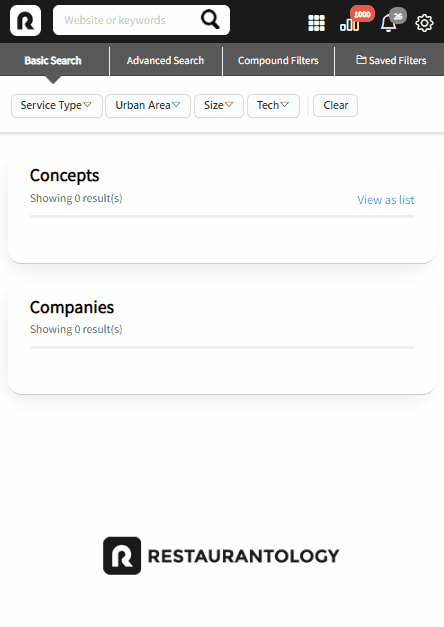Concepts and Companies
How Restaurantology defines restaurant brands and their parent organizations to support data clarity and accurate TAM reporting.
Updated over a week ago
Understanding how Restaurantology structures the relationship between brands and parent entities is critical for interpreting data, assigning sales coverage, and calculating Total Addressable Market (TAM) without duplication.
Definitions
- Concept: The customer-facing brand under which one or more restaurant units operate. Examples include Chili’s Grill & Bar, Maggiano’s Little Italy, or P. Terry’s Burger Stand.
- Company (Parent/Owner): An operating entity that owns or controls one or more Concepts and holds decision-making authority. Examples include Brinker International (parent of Chili’s and Maggiano’s). If no parent is recorded, the Concept is presumed to be self-owned and operates independently.
[!NOTE]
Restaurantology assigns a parent Company only when decision-making authority exists—not merely financial investment. For example, investors like Roark Capital are excluded unless they exert operational control over Concepts.

Hierarchy and roll-up logic
Restaurantology organizes data into a three-level hierarchy:
Unit → Concept → Company (Parent/Owner)
- Unit: Individual restaurant locations.
- Concept: Brand-level grouping for units.
- Company (Parent/Owner): Entity with decision-making authority over one or more Concepts.
If no parent exists, the Concept is treated as its own top-level entity for reporting and TAM purposes.
This structure intentionally mirrors CRM systems like Salesforce, where account hierarchies support roll-ups without double-counting.
TAM reporting and double-counting prevention
When calculating TAM or assigning sales coverage, Restaurantology ensures:
- Concepts and Companies are counted once at the highest decision-making level.
- Parent-Child relationships are respected to avoid counting both a parent and its Concepts separately.
- Self-owned Concepts contribute directly to TAM as top-level entities.
For example:
- Brinker International is counted once. Chili’s and Maggiano’s units roll up to Brinker.
- P. Terry’s Burger Stand, which has no parent, is counted as both Concept and Company.
Exceptions and nuances
Some Concepts operate without clear multi-Concept structures. In such cases, no parent is assigned, and the Concept is treated as self-owned.
Franchisee complexity introduces additional challenges. While most data adheres to the three-level hierarchy above, franchisee structures may create deeper or more fragmented relationships. These are addressed in the next article, Ownership and Franchises.
Considerations
While Restaurantology applies strict standards to maintain clarity and prevent duplication, real-world brand structures can vary. Users should be aware that:
- Some Concepts may change ownership over time.
- Not all ownership details are publicly disclosed.
- Data reflects the most recent and verified information available.
Next, continue to Ownership and franchises →

